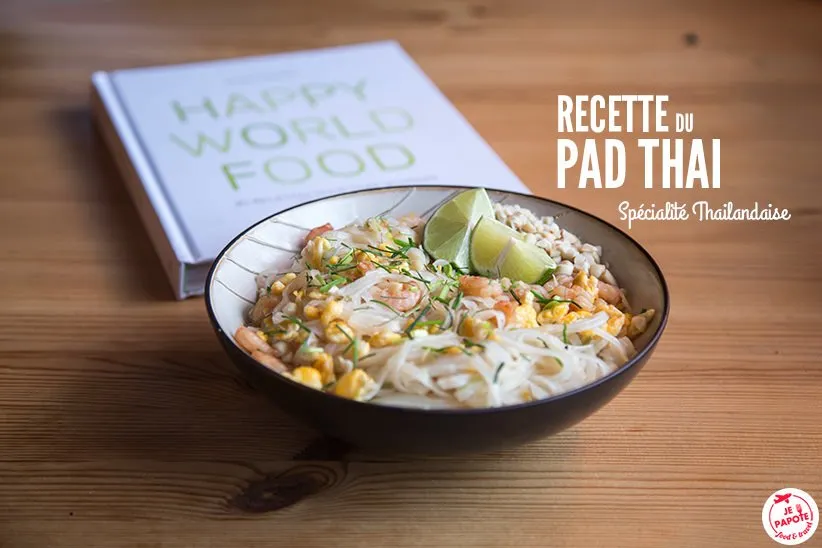
Pad Thai recipe, Thailand on your plate
If there is a cuisine that I like very much it is the one that comes from Asia. And strangely enough I have traveled very little in this part of the globe. It will be necessary that one day I cure this story to discover the authentic street food which makes the reputation of this kitchen.
So I know Asian cuisine mainly by my readings, dishes tasted at the restaurant or concocted in my kitchen. I would love to discover all these dishes in their country of origin and learn more about this cuisine that I like so much.
Today, it's Thai pad that I'm going to talk to you about. For those who have been to Thailand, you know what I'm talking about. This is the national dish of Thailand, impossible to miss this traditional dish on a trip down.
The Pad Thai
At home we talk about Pad Thai, but do not be surprised to see it written otherwise: Phat Thai in Thai simply (which means "stir-
fried Thai style) This is a pasta dish that is consumed enormously in Thailand. The rice noodles are sautéed with a lot of other ingredients that can vary according to the recipes: eggs, sprouts, tofu, shrimp, etc.
Pad Thai is said to be the national dish of Thailand because it has enjoyed national popularity following a campaign for the production of rice pasta (to reduce rice consumption). The thai pad recipe was circulated all over the country, which was the most popular dish.
For my part, it is a dish that I love a lot but I had never tried to make until recently. There is a multitude of more or less traditional recipes on the web. Difficult to navigate. The one I made and that I propose to you comes from Anne Coppin's book " Happy World Food ". It is a book that contains 80 recipes of the world. I love this book so why not trust him?

His recipe has the merit of being simple. His pad Thai is shrimp but we can quite replace them with chicken, beef and why not fish? For my part, I chose to respect the recipe as much as possible. I skipped one ingredient (despite myself): soy sprouts. Living in Lapland , I sometimes have little choice in the ingredients that I find in my small supermarket. I find pasta rice, a lot of products to cook Asian dishes but no soy to my regret. So I did without but I note it in the recipe of course.
THE RACE LIST FOR THE THAI PAD RECIPE
- 1 package of rice pasta
- 8 shrimp (I personally put the amount that suited me well)
- 2 handfuls of bean sprouts
- 2 eggs
- 2 cloves garlic
- 2 shallots
- 4 tablespoons sugar
- 6 tablespoons fish sauce
- 3 tablespoons vinegar
- 3 tablespoons of peanuts
- 3 spring onion stalks
- 1 lime
- Chilli or powder (I prefer a hot pepper paste =
- oil, salt and water
PREPARATION OF THAI PAD
Pad Thai cooking is fast. In order to make this dish a success, it is essential to prepare each ingredient for easy cooking.
- Cook the rice pasta in a large pan of water. Pasta cooks quickly, count about 5 minutes (you can go back to the pasta pack)
- Peel and chop the garlic and shallot.
- Decorate the shrimps
- Wash and chive the spring onion.
- Coarsely chop peanuts
- In a small bowl, prepare the sauce: mix the sugar with the fish sauce and add the vinegar. Mix well so that the sugar can dissolve to the maximum.
- Cut the lemon in half and squeeze the juice of one half. Cut the rest into quarters.
- In a wok over high heat, heat 3 tablespoons oil. Add the garlic and the shallot then the shrimps. Fry for a few minutes.
- On one side of the wok, break the eggs in the wok and mix them quickly to obtain scrambled eggs.
- Drain the cooked pasta and add them to the wok.
- Pour the bowl of sauce and mix.
- Add a bowl of water (a quarter of a glass), 2 pinches of soil and cook for a few minutes, stirring constantly.
- Then add the bean sprouts, lemon juice, spring onion and peanuts. Mix everything.
And now, your Thai pad is ready! You can serve it on the plates and add on the side some raw soy, crushed peanuts, chili and a quarter of lime. To taste hot to enjoy all the flavors of this dish!
